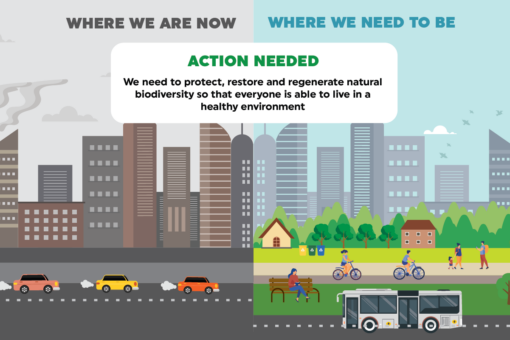
Rapid and large-scale urbanisation has had a direct consequence on wildlife in terms of land use and land cover changes. It has also fragmented landscapes, creating barriers between habitats. While many urban environments incorporate parks and green spaces, their biodiversity varies with the degree of fragmentation, management, herbicide use, local population density, and surrounding land use. Air, light and noise pollution also impact biodiversity in urbanised areas. Currently, 84% of the UK population lives in towns and cities. This is projected to increase further over the next few years.
The built environment affects both physical and mental health. Air pollution, heat, and lack of infrastructure that supports physical activity and connection with nature have both direct and indirect consequences for health. In the UK, inequalities in access to green space for exercise and recreation, combined with higher levels of air pollution in the most socioeconomically deprived areas, threaten the physical and mental health of millions of adults and children. The impacts of the lack of access to high-quality green space were particularly evident during lockdowns put in place during the COVID-19 pandemic: people living in flats, without access to gardens or green space were more acutely affected.
Well-managed, high-quality green and blue spaces in urban environments can both enhance biodiversity and restore nature bringing multiple health benefits. They provide shading and reduce areas of raised temperatures experienced in cities and urban spaces (urban heat islands), positively affect physical and mental health and wellbeing, and provide adaptation to extreme heat. The presence of such biodiverse natural spaces (for example with a diverse group of flowering plants and trees) within urban infrastructure provides habitat for the declining species of pollinators.
In 2020, the total value of ecosystem services in England was estimated to be £35.7 billion. More than half of it was derived from cultural services, mainly recreation and tourism and the health benefits associated with it. The health benefits through the removal of air pollution by vegetation was estimated to be £2.17 billion, out of which £1.86 billion was due to PM2.5 removal. Further, by enabling people to spend sufficient time in nature each week (minimum of 2 hours) health benefits based on quality-adjusted life years was £5.7 billion between 2018 to 2020. A review of green spaces by Public Health England concluded that £2.1 billion per year could be saved in health costs if everyone in England had good access to green space. Fields in Trust estimate that reduced GP visits as a result of access to parks and green spaces would save the NHS around £111 million per year. The health service is responding through initiatives such as NHS Forest, which is aimed at transforming health sites into healthy, biodiverse green spaces and includes over 300 UK healthcare sites.
The UK Government Environmental Improvement Plan includes a commitment that every person should have access to green space or water, such as wetlands, woodlands, parks and rivers within a 15-minute walk from their home. With 80% of people living in towns and cities, one-third of the population currently does not have access to green or blue space within 15 minutes of their homes. Natural England’s Green Infrastructure Framework provides a system for analysing where green infrastructure in urban environments is needed most to support equitable access to green spaces across the country. A greenspace interactive map and open space audit and strategy for planning authorities in Scotland have been produced by NatureScot to help deliver the Scottish Planning Policy. The Wales Green Infrastructure Forum is focused on promoting green infrastructure in towns and cities in Wales.

Protect, restore and regenerate nature and biodiversity in urban landscapes.
The aim is to reach the ratified 30% biodiversity target by 2030. This can be achieved through multi-level, cross-sectoral partnerships and collaboration to collectively design and deliver high-quality green and blue spaces in urban areas and NHS sites such that it enables physical and mental health and well-being and green social prescribing. These spaces should be designated as key health infrastructure that would improve population health.
